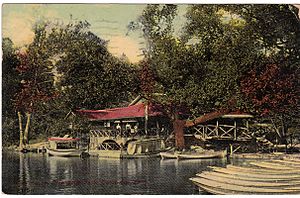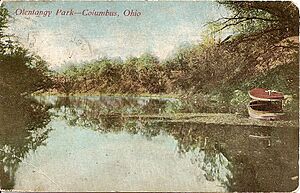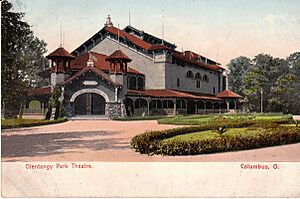Olentangy Park facts for kids
Olentangy Park was a popular amusement park in Clintonville, Columbus, Ohio. It was open from 1880 to 1939. Many people visited it for fun rides, a large swimming pool, and beautiful gardens.
Contents
- Where Was Olentangy Park Located?
- The Park's Exciting History
- What's Left of Olentangy Park Today?
- Images for kids
Where Was Olentangy Park Located?
Olentangy Park was in the southwest part of Clintonville. It was next to the Olentangy River on the west. North High Street was on its east side. North Street was to the south, and it reached almost to West Tulane Road in the north.
The Park's Exciting History
Early Days: Robert M. Turner (1880–1899)
Before 1880, the area was just a forest by the Olentangy River. People liked to go there for picnics and swimming. In 1880, Robert M. Turner bought this land. He created a picnic area and a swimming spot in 1881. He also built a tavern and called the place "The Villa." For many years, not much changed. A few small rides, like a carousel and pony rides, were added.
New Owners: Columbus Railway, Power and Light Company (1895)
In 1895, the Columbus Railway, Power and Light Company bought "The Villa." The park was at the end of their North High Street trolley line. The company wanted to attract more riders to their trolley. They added electric lights to the park in 1896. The tavern stayed open for visitors.
The Dusenbury Brothers Take Over (1899–1909)
In 1899, the Dusenbury brothers bought 100 acres of "The Villa." They renamed it Olentangy Park. They started to build it into a real amusement park. Their first big addition was a roller coaster called "The Figure Eight." After the 1904 World's Fair in St. Louis, the brothers bought the "Japanese Gardens" exhibit. They moved it to Olentangy Park. These gardens were a peaceful place away from the noisy rides. A huge theatre was built near the river. It was one of the biggest theatres in the United States at that time. In 1907, they built the country's largest dancing pavilion. They also cleared a picnic area in a valley. Wooden bridges were built to connect different parts of the park. By 1910, the park had grown a lot. They added a zoo with monkeys, bears, and elephants. A boat house, called the "Canoe Club," was built by the Olentangy River. Visitors could rent canoes for a calm boat ride. An arcade was built with many indoor rides. These included "The Olde Mill" and the "Tunnel of Love." A restaurant replaced the old tavern. More electric lights were added all over the park. The North High Street Trolley even went right into the park. This made Olentangy Park a "Trolley park." People could easily reach it from anywhere in the city.
More Growth: The Dusenbury Brothers (1910–1923)
Exciting Rides of the 1910s
Olentangy Park grew very quickly after 1910. Some of its most famous rides were added then. One ride was the "Loop the Loop." It was one of America's first roller coasters with a loop. It was later removed because it was too hard on the riders. Other rides included the "Whirlwind" and the "Red Devil." The "Red Devil" roller coaster was very close to North High Street. Riders would soar high above the road. A Ferris wheel, a swing ride, and pony rides were also added. "Shoot-the-Chutes" was a tall water slide. Riders got into a flat boat that went up a ramp. Then it shot down the slide, making a huge wave! An elephant was even trained to ride down the slide. In 1914, a special carousel was bought for the park. It had 52 horses and 2 chariots. These were hand-carved by a famous artist named Marcus C. Illions. This "Grand Carousel" was very rare. The park continued to expand with more land added in 1915 and 1917.
The Giant Swimming Pool of the 1920s
A huge addition in the 1920s was the world's largest swimming pool. It was built near the theatre. The pool was hundreds of feet long and could hold many swimmers. To make it feel like a beach, hundreds of tons of sand were brought in. This created a sandy area around the pool. This pool was the largest in the world for many years. It was the third largest ever built in the United States. Building all these new things was expensive for the Dusenbury brothers. Also, fewer visitors came in 1923. So, the brothers sold Olentangy Park to a group of investors called "The Olentangy Amusement Company." Max Stern managed the park. The park continued to do well for the rest of the 1920s.
Leo and Elmer Heanlein (1929–1937)
In 1929, the Heanlein brothers leased the park and took charge. They made the zoo bigger and added a fun house to the arcade. During the Great Depression, many amusement parks struggled. But events and shows at Olentangy Park helped it stay open.
The Final Years: L.L. LeVeque Company (1937–1939)
In 1937, the L.L. LeVeque Company bought Olentangy Park. They planned to sell the rides and equipment. The Gooding Amusement Company bought the carousel, the Ferris wheel, the airplane ride, the dodgem cars, and the rifle range. Many of these rides were moved to Wyandot Lake Amusement Park. Olentangy Park closed in September 1938. In early 1939, much of the park was torn down. The L.L. LeVeque company built the Olentangy Village apartment complex there.
What's Left of Olentangy Park Today?
In 1940, a bowling alley called Olentangy Lanes was built where the park's parking lot used to be. It burned down in 1980. The park's "castle gate" and theatre also stayed until 1940. They were both destroyed by fires. The only building left is the park's old office and zoo keeper's house. This stone building is on North Street. It has been turned into six apartments. Some of the park's original iron fence can still be seen along the north side of North Street. This fence has a special "O" pattern. The same part of North Street was once the park's main entrance for people walking in. The foundation of the park's "Canoe Club" and the steps to the theatre are partly hidden. They are on the banks of the Olentangy River, north of Ackerman Road. You can also see the concrete bases of the old wooden bridges. These are on both sides of the streams in the picnic valleys. One of these old picnic valleys is behind a tanning salon on North High Street. It is now overgrown.
The Famous 1914 Mangels-Illions Carousel
Olentangy Park's beautiful 1914 Mangels-Illions carousel was moved in the 1930s. It went to Scioto Ranch Park, which later became part of Wyandot Lake Amusement Park. This park is near the Columbus Zoo. The carousel kept running, even though it was getting old. In 1999, it was taken out of Wyandot Lake. A company called Carousel Works Inc. carefully restored it. The carousel started running again in spring 2000. It is now in a special building at the Columbus Zoo and Aquarium. In its first month there, 42,000 people paid to ride it! On July 28, 2004, the carousel celebrated its one millionth rider since it was restored and moved to the zoo.
The Giant 1920s Swimming Pool
The Olentangy Park swimming pool was used for many years as part of the Olentangy Village apartment complex. In 1996, the pool was made half its size to make room for new apartment buildings. Finally, in 2002, the rest of the pool was filled in. This created more space for the village.
- Olentangy Park at the Roller Coaster DataBase
Images for kids





